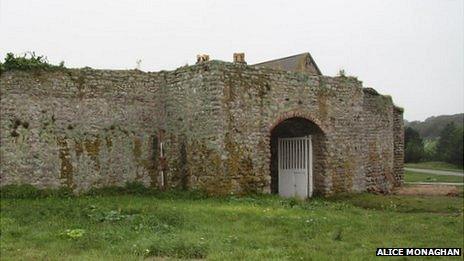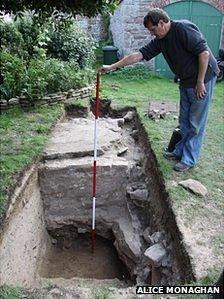Alderney ruin found to be Roman fort
- Published

Besides various military uses, the site has also hosted a farm, the residence of the island's governor and holiday homes
An overgrown site on Alderney has been found to be one of the best-preserved Roman military structures in the world.
Island tradition had long suggested the site, known as the Nunnery, dated back to Roman times, although excavations since the 1930s had always proved inconclusive.
A joint project between Guernsey Museums and the Alderney Society was set up in 2008 to find the answers.
Over four August bank holiday weekends, a team of a dozen volunteers undertook various excavations to determine the history of the site.
Dr Jason Monaghan, Guernsey Museums director, said: "In 2009 we proved there was a Roman building inside the Nunnery and began to suspect this was a tower as all the northern English forts have a tower in the middle.
"In 2010 we went back specifically looking to prove there was a tower there - and 'wow' is there a tower.

Dr Monaghan said the inside of the tower was cleared out during WWII
"The walls are 2.8m (9ft) thick, we don't know how high it was, but it would have been a very big structure - it's as thick as Hadrian's Wall."
The tower was found to be about 18 sq m. (58 sq ft).
He said the team dug down to prove the outside walls were also Roman before doing the same for the gateway.
The site has been extensively built on.
It medieval times it was a fort and barracks, and later the governor's residence, a farm, a German barracks during World War II, British military accommodation and holiday homes.
Dr Monaghan said: "It's in an extremely good state of preservation... it's better preserved than all the other small Roman forts in Britain.
"It's in a better state than what they call the Saxon shore forts off southern England, it's in better nick than most of Hadrian's Wall.
"The other beautiful thing about it is that it is very small and very easy to understand. A lot of archaeological sites you go there and you actually need a PhD to understand what's going on.
"But the Nunnery you can understand - it's a fort, it's guarding the bay, it's got walls, it's got towers, you can very easily get your head around it."
'Nervous' Romans
Dr Monaghan added: "It probably guarded the entrance to Longis Bay, Alderney's only natural harbour, and I think they would probably have based a couple of Roman warships there.
"It's only eight miles to the French coast, you can see right the way across from there, and if you want to control that waterway and stop pirates or anybody else going past, that's the ideal place to do it.
"The fort protects the beach because we know there was a settlement as well, probably a little Roman village or little town underneath the sand of Longis."

The work to excavate the site was carried out by a team of a dozen volunteers over four years
He said the fort was constructed very late in the Roman period: "This was built in the late 4th Century.
"It's a time when they were very, very nervous about what was going on in the Roman Empire, they weren't feeling very happy at all, so they put these forts all over the place."
The most obvious sign of the old Roman fort are the battlement crenellations, which were built on with medieval stone but are still visible.
As to the future care of the site, which is currently tenanted, Dr Monaghan said funding was an issue and at the moment its preservation was down to the volunteers who were carrying out their work with the permission from the landowner.
He said he hoped the project highlighted its importance and would mean the site would receive the care it deserved.
- Published17 November 2011
- Published4 November 2011
- Published25 October 2011
- Published1 September 2011
- Published26 July 2010